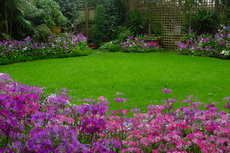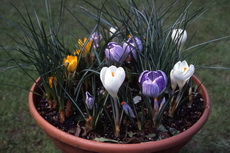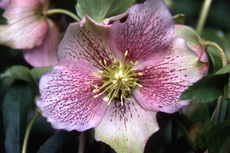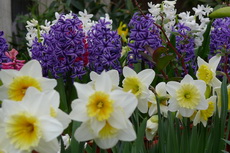
 September 1 marks the calendar beginning of spring but the truth of the matter for most Gardeners in cool temperate climates is that the first real "spring days" are still some weeks away. While Subtropical Gardeners have been experiencing spring-like days.
September 1 marks the calendar beginning of spring but the truth of the matter for most Gardeners in cool temperate climates is that the first real "spring days" are still some weeks away. While Subtropical Gardeners have been experiencing spring-like days.And for some time and it shows throughout the garden. The wise gardeners know that there is a special ‘tonic’ almost guaranteed to lift the spirits, rekindle hope, and inspire renewed motivation even in the face of relentless pounding late season storms. The tonic: a bright winter garden. The sparkle it can bring proves it to be a powerful medicine.
Even a few choice flowering plants in containers on the windowsill, a cluster of pots by the back door or a small winter-sheltered garden bed can have as much impact as a field of spring
 wildflowers.
wildflowers.Hardy winter flowers often are natives of drier regions where they naturally flower at this time of year when weather is both cooler and damper. Others are hardy species that produce flowers under adversely cool or cold conditions and short growing seasons.
Winter flowers enjoy sunshine and warmth as much as the rest of us. Successful winter gardens are carefully planned to benefit from all available sunshine and warmth. In colder climates winter flowering species are limited and will start flowering later in the season. Mild Subtropical climates can maintain quite diverse and attractive displays all winter. As day length and temperature increase so does flowering; often reaching a peak around late winter and
 early spring.
early spring.Advanced seedlings or instant color pots can bring an immediate splash of colour and fragrance to brighten a winter-weary garden. Many Gardeners find the expense a worthwhile purchase. But to produce a real winter garden takes some special advanced planning and preparation.
Here is how to make a winter garden:
Seed is sown from mid-summer to the first of winter (January to June in the Southern Hemisphere), mostly in earliest days of autumn (March), for planting out in the latter days of  autumn (May or April in colder districts with shorter seasons).
autumn (May or April in colder districts with shorter seasons).
As summer gardens fade beds are cut-down, cleared, dug and fed with blood and bone; dolomite or some form of lime or shell; and dusted with a general balanced granular plant food. Wherever the winter season could prove challenging, mix into the soil extra phosphate, potash and trace elements; these will increase vigour and bloom quality. Wintry conditions make plant foods less available to the plant so feed rather heavily and/or add plenty of compost, aged manure or peat into which the fertilizers will absorb and be gently released over time. Whenever attempting a winter garden in clay or other heavy, wet soil, be sure to improve drainage by digging in lots of sand, gravel and/or bark to which Gypsum can be added; or consider elevating the bed or growing plants in large and broad containers partially submerged in the garden bed.
Bulb flowers are a special component of most late winter and spring garden display. When planting the winter garden it is easiest to plant them first; although they can be planted anytime from early autumn through early winter. Then over-plant between the bulbs with annuals and perennials of a compatible nature to the bulbs which will later pop up in between them. For longest possible flowering season and maximum winter bloom, it is important that seedlings have advanced to near first bud stage by the first autumn frost. Once frost and colder conditions arrive, buds and blooms will open more slowly but last much longer in refrigerated winter air.
To maintain displays cultivate, feed and weed regularly but lightly. The wise gardener always sets aside extra seedlings from the autumn planting which are grown on in a sheltered and winter-protected corner. These extra pots of colour will be ready to prolong the show or fill-in holes where something has collapsed.
Winter gardens work best when planted on the sunny and sheltered side of tall hedging; in a sunny patch under a canopy of trees or large shrubs; near sheltering, sunny warm walls and buildings; and in milder subtropical climates in a wide variety of protected sites. In Temperate climates where winters can prove temporarily extreme, expect damage where repeated freezing is severe but even there some limited winter colour is easily attainable and especially so throughout most of milder garden environments of the Southern Hemisphere.
MORE PICTURES click here...
READ MORE...e-Book Autumn Glory
 autumn (May or April in colder districts with shorter seasons).
autumn (May or April in colder districts with shorter seasons).As summer gardens fade beds are cut-down, cleared, dug and fed with blood and bone; dolomite or some form of lime or shell; and dusted with a general balanced granular plant food. Wherever the winter season could prove challenging, mix into the soil extra phosphate, potash and trace elements; these will increase vigour and bloom quality. Wintry conditions make plant foods less available to the plant so feed rather heavily and/or add plenty of compost, aged manure or peat into which the fertilizers will absorb and be gently released over time. Whenever attempting a winter garden in clay or other heavy, wet soil, be sure to improve drainage by digging in lots of sand, gravel and/or bark to which Gypsum can be added; or consider elevating the bed or growing plants in large and broad containers partially submerged in the garden bed.
Bulb flowers are a special component of most late winter and spring garden display. When planting the winter garden it is easiest to plant them first; although they can be planted anytime from early autumn through early winter. Then over-plant between the bulbs with annuals and perennials of a compatible nature to the bulbs which will later pop up in between them. For longest possible flowering season and maximum winter bloom, it is important that seedlings have advanced to near first bud stage by the first autumn frost. Once frost and colder conditions arrive, buds and blooms will open more slowly but last much longer in refrigerated winter air.
To maintain displays cultivate, feed and weed regularly but lightly. The wise gardener always sets aside extra seedlings from the autumn planting which are grown on in a sheltered and winter-protected corner. These extra pots of colour will be ready to prolong the show or fill-in holes where something has collapsed.
Winter gardens work best when planted on the sunny and sheltered side of tall hedging; in a sunny patch under a canopy of trees or large shrubs; near sheltering, sunny warm walls and buildings; and in milder subtropical climates in a wide variety of protected sites. In Temperate climates where winters can prove temporarily extreme, expect damage where repeated freezing is severe but even there some limited winter colour is easily attainable and especially so throughout most of milder garden environments of the Southern Hemisphere.
MORE PICTURES click here...
READ MORE...e-Book Autumn Glory





